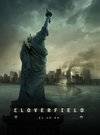|
|
||||
|
|
by Jeffrey Chen  If current movies like Cloverfield are any indication, self-preservation is now less instinctive than ensuring the safety of a loved one, even if it means having to face off against giant monsters. Think of the recent Korean movie, The Host, with its central family willing to risk life and limb to save their youngest member. Here, in Cloverfield, we're following the self-documented footage of a small group of twentysomethings following the lead of a guy determined to rescue a sweetheart, heading straight into a ravaged New York while everyone else is trying to get out. I suspect such a presentation reflects what happens as the world gets smaller and the internet, mass media, and technology give more presence to individual experiences. Cloverfield's an updated Godzilla movie, after all, with its monster senselessly mashing New York as a 9/11 metaphor the same way Japan's lightning-breathed lizard blasted Tokyo as a metaphor for Hiroshima. But the older films followed characters who had connections with authorities and could actually observe their steps to neutralize the attackers. These days, what the authorities are doing doesn't matter as much as the reactions of average individuals. It's the difference between the 1950's War of the Worlds and the recent one. Do we see disasters as so inevitable now that all that matters is what happens to each of us as they are happening? In such a world, the importance of protecting those close to us becomes magnified. We cling to our loved ones because we can make sense of each other. So Cloverfield starts off being intriguing by positing that we'd save loved ones' lives first before our own. Self-preservation is less literal now -- it may mean, instead, that someone documented our lives and efforts with a camera as proof of our own existence. Admittedly, Cloverfield would've worked better in exploring this modern scenario were it not so conspicuously constructed from the outside in. The movie uses a hip approach that gives away its intentions as leaning more towards admiring its own technique than being about people in a disaster situation. For one thing, its cast are of the stereotypical horror movie victim demographic -- not necessarily teenagers, but young enough and good-looking enough that we automatically put up defenses to distance ourselves from them, since we know at least half of them will be killed and all we'll be looking forward to is the spectacle of it. It's a small cast, but at least two of them are dispatched in rather spectacular fashion, which leads one to think the number of the main cast was decided upon based on the number of cool death ideas to be filmed. Also, the movie's most distracting feature is its own conceit -- that the story is told Blair Witch Project-style, through found footage of someone videotaping the evening. The cast start out at a goodbye party for one of their own, Rob (Michael Stahl-David), but when the destruction comes down, the guy in charge of taping the testimonials (T.J. Miller) decides to keep the camera on and film everything that's happening, all the way through Rob's mission of rescuing the girl he loves (Odette Yustman). As such, only glimpses of the monster are caught, but meanwhile other questions kept popping up in my head, like, if this is found footage, why is it so well-edited? Why does the cameraman look at everything through the camera when common sense would have anyone put it down once in a while just to gain bearings? But these are things one should ignore -- with a movie like this, the idea, of course, is to run with it. After all, it mainly wants to duplicate the urgency and disorientation of what it might feel like to be there -- and it does so effectively. Still, the bad side effect of this idea is to incorporate everything that goes with being handheld footage, which includes the dreaded shaky-cam. The more I see shaky-cam, the more I'm against its use for theatrical exhibitions. It's just not natural -- home video camera operators would avoid it if they could, and in real life you don't see the world bouncing about because your brain stabilizes what you see. On a big ol' movie screen, the shaky effect only serves to amplify nausea. I don't care how much more realistic it seems -- you wouldn't watch home videos on a giant movie screen for the exact reason that Cloverfield is a challenge to watch, namely, it comes close to making you lose your lunch. Well, it got close for me; I heard others might not have been as lucky. As a product of our globally-aware disaster-ridden times, Cloverfield touches upon interesting themes because it intersects reactions to the destructive and uncontrollable with technology and the youth who adapt to it (this made the scene where onlookers used their cameraphones to snap pics and vids of the decapitated head of the Statue of Liberty one of the more interesting ones). But it doesn't do much more than just glaze over this. Even as it attempts to depict its characters' fates as something resembling an intimate tragedy, it reaches out to the spectacle-seeker in us, giving us teasing views of the monster. When the camera operator expresses elation and fear as he sees the creature getting bombed from a high vantage point, the sight of it clawing down the side of a skyscraper for balance tempts us to dismiss the emotions by asking, "Wasn't that cool?" (Released by Paramount Pictures and rated "PG-13" for violence, terror and disturbing images.) Review also posted at www.windowtothemovies.com. |
||
|
© 2025 - ReelTalk Movie Reviews Website designed by Dot Pitch Studios, LLC |



